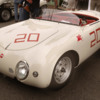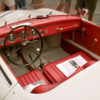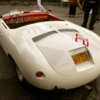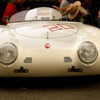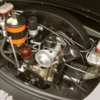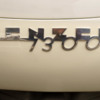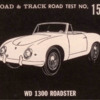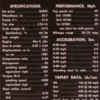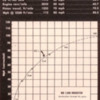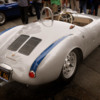The car pictured is a later model DK 151 - made around 1957. By then, the cars were built on custom steel tube frames - no longer on VW chassis. Here's maybe more than you want to know about these cars from the web:
Jim Perrin Editor, Denzel Bulletin:
Denzel – These are great cars! The photos of the two white cars posted above by Mike G. are of the 1957 Denzel DK 151 (has race no. 20 on it) and the 1958 Denzel DK 158. Both originally had 1300 Denzel engines in them, and both still do have Denzel engines in them. Over the years, many Denzel engines were replaced by either VW or Porsche engines as Denzel parts became very difficult to obtain. The last Denzel (owned by me) was completed in mid-1960, over 50 years ago, which is why parts have been so difficult to obtain for many years.
I know of no evidence that the Denzel factory ever put a Porsche engine in any of their cars. An individual owner certainly could, either because his Denzel engine was not running or he wanted the power of a Porsche 1600 cc engine. Incidentally, Denzel made 1100, 1300 (two versions) and 1500 engines (two versions, both very rare). DK 151 (produced in 1957) came with a Denzel engine (see period road test with engine photos of this very car in the circa December 1957 Road & Track), DK 158 (produced in 1958) still has its original Denzel engine, and DK 160 (produced in 1960) came with a Denzel engine.
Peter Denzel’s DK 164 (completed in 1959) also has a Denzel engine in it. When you study period photos of engines in Denzels, you can always tell whether or not it has Denzel cylinder heads, as the spark plugs (and holes for them in engine sheet metal) are at a much different angle than those in Porsche or VW engines. Another feature of the later Denzel engines in Denzel cars was a large-diameter full-flow oil filter, as opposed to the smaller by-pass filter used in Porsche.356′s.
Early Denzel engines were mostly VW parts. However, by the mid-1950′s, Denzel had its own crankshafts, pistons and cylinders (made by Mahle), its own cylinder heads, and its own valve train including rocker arms and push rods. Also, virtually every one of the many sheet metal pieces on the engine were unique to Denzel. The only major component that was still produced by VW was the engine case.
And a data panel from a 1957 Road and Track review. They say it weighed only about 1400 pounds. The sketch in the R&T article shows a steel-framed windshield though, not the plexiglass of the car in my photos. (But this may explain why the roll-up 'half windows' start where they do if the car originally had vent windows.)










